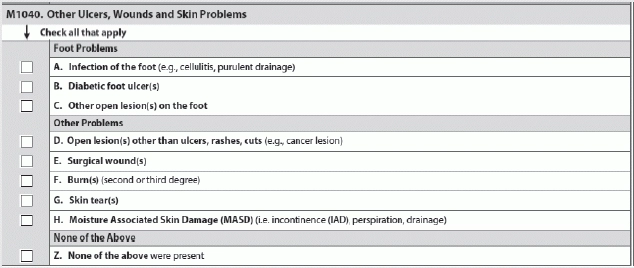Heed Expert Tips For Coding M1040
When you can code a skin ulcer as a surgical wound.
You’ve carefully staged all those pressure ulcers in Section M, but you’re not done yet. M1040 (Other Ulcers, Wounds and Skin Problems) is just as important an area in Section M as the previous areas on pressure ulcers.
M1040 is separated into three subcategories:
• Foot Problems
o A. Infection of the foot
o B. Diabetic foot ulcer(s)
o C. Other open lesion(s) on the foot
• Other Problems
o D. Open lesion(s) other than ulcers, rashes, cuts
o E. Surgical wound(s)
o F. Burn(s)
o G. Skin tear(s)
o H. Moisture Associated Skin Damage (MASD)
• None of the Above
o Z. None of the above were present
Don’t Neglect to Examine the Resident
To get started on completing M1040, “review your medical record, review your flow sheets,” Jeff Levine, MD, clinical assistant professor for the department of medicine (geriatrics) at the Albert Einstein College of Medicine, stated in a Centers for Medicare & Medicaid Services (CMS) instructional session. “Review your treatment records for the look-back period.” And you need to speak with the direct-care staff.
“Confirm your conclusions from the medical record, and examine the resident,” Levine urged. “Please examine the resident.”
Where to Find Diabetic Foot Ulcers
And if you don’t examine the resident, you won’t find some potential skin problems like diabetic foot ulcers (M1040B).
“Diabetic foot ulcers usually occur on the plantar aspect of a foot of a patient with long-standing diabetes,” Levine explained. These types of ulcers are not always on the plantar aspect and the head of the metatarsals, “but that’s the most common area of repetitive pressure where patients get this.”
“And those ulcers are usually not painful because the ulcers occur in a setting of diabetic neuropathy, where the patient has a stocking and glove distribution of anesthesia in the lower extremity,” Levine noted.“ So the patient may not even know it’s there.”
Important: Also, anytime you examine a resident with a diabetic foot ulcer or any other foot problem, make sure that you examine the other foot, Levine stressed. “If it’s one foot, examine the other foot.”
Avoid Common Mistakes with Surgical Wounds
“M1040E is where you put your surgical wounds,” Levine stated. But remember that if the resident has an ulcer debrided, “it is not a surgical wound.” This would still be considered an ulcer.
Caveat: “If an ulcer goes for a flap surgery, that’s a different story,” Levine pointed out. “The patient comes back; it’s now coded as a surgical wound. That’s the only time when an ulcer is transformed into a surgical wound — after flap surgery.”



